A GREAT DEAL of the results will depend on the exhaust header design,MOST commercial headers are designed with low cost and ease of installation in mind rather than max scavenging and max HP. KEEP IN MIND the main function of headers is to increase the efficiency of the SCAVENGING of the spent gases in the cylinder and help draw in the following next fuel/air charge in the intake runner of that cylinder,thru the use of timing negative pressure cycles,and reversion pulses in the exhaust port, but the exhaust restriction level behind the headers can kill most of the potential results from even the better designs, ANY SIGNIFICANT RESTRICTION TO FLOW AND RESULTING BACK PRESSURE WILL HURT YOUR RESULTS ,if your not willing to change the whole system to optimize the results , and lower the restriction to flow past the collectors on those headers, then a stock or modified stock or shorty headers will be a decent choice, if the FULL LENGTH HEADERS are MATCHED to a full length, 3" exhaust with an (X) that will significantly lower the restriction to flow rates. the stock corvette exhaust manifolds tend to be far better than most stock exhaust manifolds but they still fall far behind what a decent set of full length headers and a low restriction exhaust will do for your cars power.
design the system correctly and you can significantly increase the exhaust scavenging of the cylinders and increase power,do it wrong and youll hurt power.
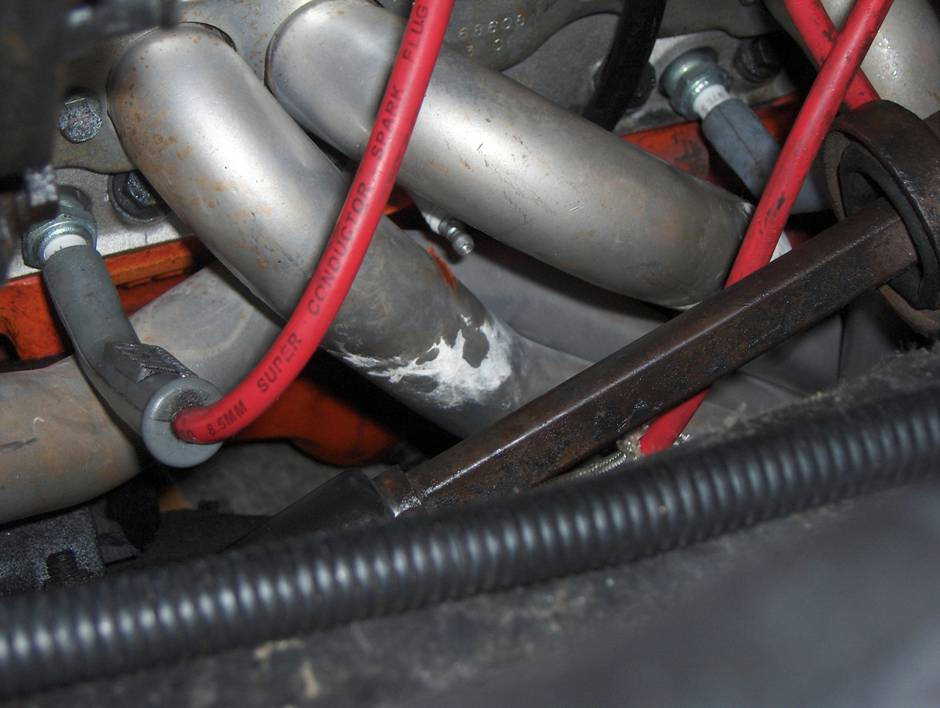
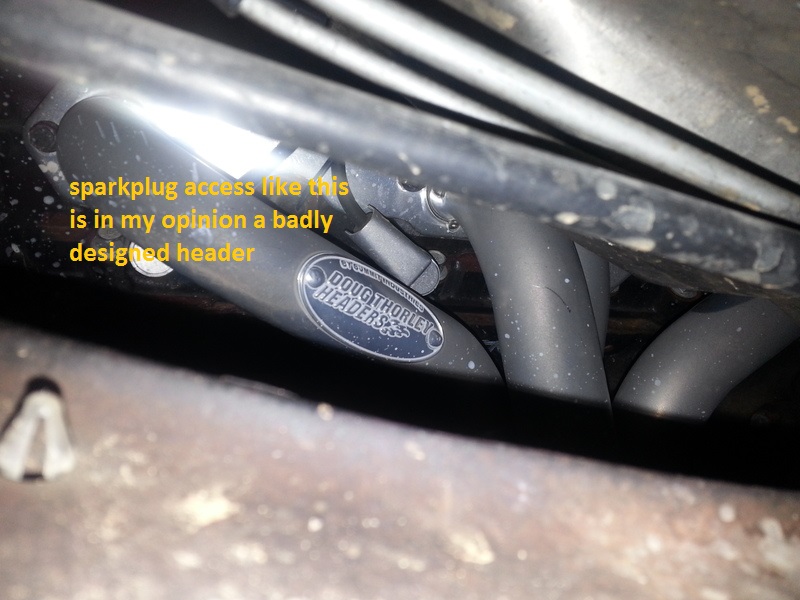
HEADERS LIKE THIS SET PICTURED ABOVE< ARE VERY POORLY DESIGNED, AND ALMOST WORTHLESS, AS THEY WILL DESTROY THE SPARK PLUG WIRES WITH HEAT RAPIDLY

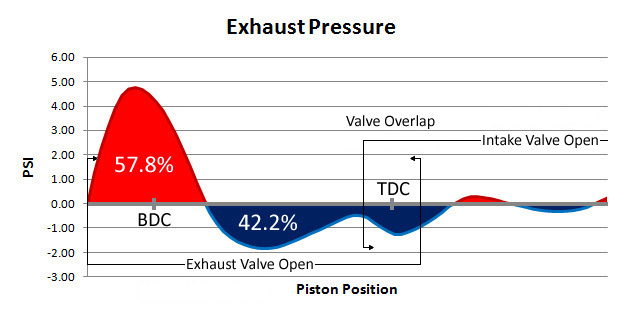

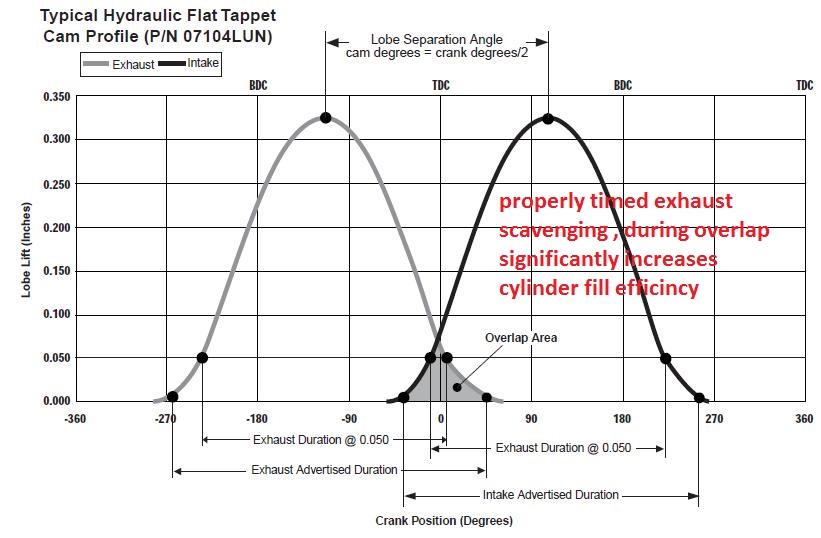
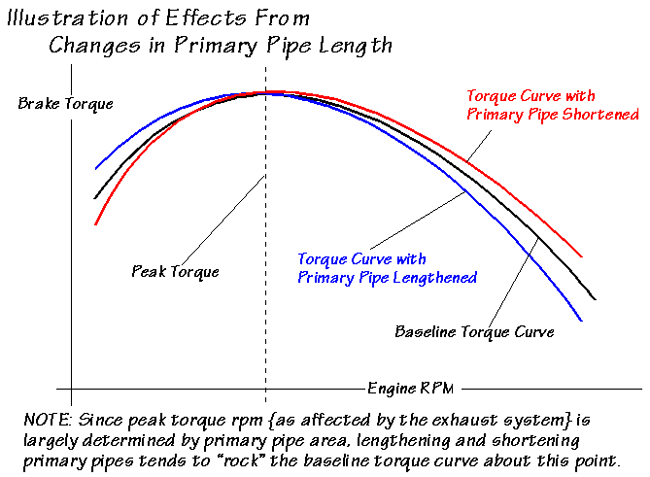
keep in mind installing an (X) almost increases the effective cross sectional area,of the dual exhaust ,to double what it had been behind a single header collector, by doubling the area that the exhaust flow sees, dropping the restriction to flow almost in half
http://www.antechlabs.com/K0GFM/pipechart.gif
READ THRU THESE ALSO
http://www.custom-car.us/exhaust/default.aspx
viewtopic.php?f=56&t=1730&p=4310#p4310
http://www.headerdesign.com/extras/design.asp
http://www.slowgt.com/Calc2.htm#Header
heres some tools to help, if your building your own custom exhaust
http://www.metalgeek.com/static/cope.pcgi
http://pipemastertools.com/store/page1.html
viewtopic.php?f=56&t=352
viewtopic.php?f=56&t=1166&p=2387&hilit=side+pipes#p2387
http://stockcarracing.automotive.com/49 ... sions.html
http://www.bgsoflex.com/bestheader.html
http://www.veryuseful.com/mustang/tech/ ... enging.pdf
viewtopic.php?f=38&t=1002&p=1805#p1805
viewtopic.php?f=56&t=1503
http://www.centuryperformance.com/exhau ... g-137.html
http://www.wallaceracing.com/header_length.php
http://store.racing-solutions.org/
viewtopic.php?f=56&t=495&p=2008&hilit=+pipe#p2008
http://www.superchevy.com/technical/eng ... index.html
http://www.sjdiscounttools.com/waebpt01.html
readings above about 1.5 psi usually indicate a restriction thats costing you power.
the main IDEA is to REDUCE restriction and EQUALIZE the flow, AND INCREASE the CYLINDER SCAVENGING to help power by increasing the cylinder filling efficiency. side benefit is usually a more mellow exhaust tone
lets say your car has two 2.5" exhaust pipes, blending the flow thru use of an (X) doubles the area and cuts the restriction almost in 1/2, plus if designed correctly it helps scavenging, a single 2.5" pipe cross section is approximately 4.9 SQ" a single 3" has approximately 7 sq inches of cross sectional area, so adding an (X) effectively reduces the restriction almost in half but stepping up the size and adding an (X) beyond the header collectors does far more at reducing the restriction
THE (X) BY FAR is more effective, the (H) may equalize the pressure to a great extent but the (X) blends and equalizes the flow, READ THRU THE LINKS AND PAY ATTENTION TO THE MATH
http://www.uucmotorwerks.com/html_product/sue462/backpressuretorquemyth.htm
http://victorylibrary.com/mopar/lcb-c.htm
http://victorylibrary.com/mopar/header-tech.htm
http://www.pontiacracing.net/js_header_length1.htm
http://www.engr.colostate.edu/~allan/fluids/page7/PipeLength/pipe.html
http://auto.howstuffworks.com/question172.htm
http://www.pontiacstreetperformance.com ... haust.html
http://www.burnsstainless.com/TechArtic ... heory.html
http://www.classicchambered.com/classic/products.html
http://www.slowgt.com/Calc2.htm#Header
http://www.superchevy.com/technical/engines_drivetrain/exhaust/0504sc_header/index.html
http://www.vetteweb.com/tech/vemp_0401_ ... index.html
http://www.carcraft.com/techarticles/header_basics/index.html
you can easily measure this, get a pressure gauge and drill a 1/8" hole in the exhaust behind the headers and bring the engine up to full throttle with the gauge attached, (I usually suggest running thru the gears on a semi hard acceleration test run with a partner in the pass seat watching the gauge readings, with a temp test line to the gauge running into the cab thru a window.
whats the difference?
lets say for the example the exhaust pulse is a quart to water moving at several hundred feet per second, but unlike water it can be compressed,since the exhaust pipe inside diam. is set the length of the pulse or slug of exhaust exiting the engine every 90 degrees of rotation (v8) has inertia/energy/mass, if it passes a right angle low pressure exit point, at first it flows into both routes but as the mass passes the opening a slight negative pressure forms and it reverses and the flow changes, put a vacuum gauge on the (h) and it vibrates, wildly.
install an (X) and the flow from both sources is FORCED to BLEND, line up, equalize and BOTH sections of the up stream flow benefit from the
as each inertia/energy/mass, and slight negative pressure that forms, but its far more equalized. gases unlike liquids will expand to fill any void.
put another way if one side was pumping out dark green water and one side was pumping clear, an (H) would have dark green exiting one side and light green exiting the other, an (X) would have both sides an equal, slightly lighter green flow .now at low rpms , or with a smaller than ideal pipe dia. thats no big deal, but at high rpms, BOTH the SCAVAGING of the cylinders your trying too scavage enhances the effect and the reduction of the restriction to flow tends to be better with the (X) put a vacuume gauge on the (X) and it vibrates. but not to nearly the same extent, and the changes in pressure reading remain more consistent
BUT,DON,T be thinking that either is a mandatory huge improvement, it may or may not help the power, the degree of restriction, displacement, compression ratio, cam timing and the efficiency of the headers has a good deal to do with your results, and sticking restrictive mufflers on past the (X) or (H) can effectively kill most of the potential benefits
a header design like that could be , and frequently is designed to work really effectively at a SINGLE RPM point, that's why dragsters with slipper clutches use them, the COLLECTOR length and diam. can be tuned to effectively widen and extend the rpm band where the cylinder scavaging is effective
as primary pipe diam. increases the flow velocities drop off faster and the energy tends to dissipate, as the length gets shorter the rpm range goes higher, collectors can widen the rpm range where headers are effectively scavaging the cylinders,there's the necessary math in the links provided above, and below remember the idea is to increase the cylinder scavaging thru tuning the length and diam of the primary and collectors to maximize the volumetric efficincy and resulting torque over the widest possible ,USEFUL rpm band
the basic concept and math, and info worth reading
http://victorylibrary.com/mopar/header-tech-c.htm
http://www.geocities.com/MotorCity/Track/6992/vizard.html
http://store.racing-solutions.org/
a single 2.5" pipe cross section is approximately 4.9 SQ" a single 3" has approximately 7 sq inches of cross sectional area, the (y) consisting of two 2.5" pipes feeding a 3" pipe won,t be as good as MOST (X) pipes but its certainly an improvement in some cases over a small (H) pipe, as its probably less restrictive, the saving grace here is that as the exhaust flow moves thru the exhaust its losing heat, pressure and condensing and the fact that its pulsed so the cylinders fire 90 degrees apart allowing the flow to blend and space out the flow.
your results will vary with displacement and rpm ETC. but and reduction in flow restriction past the collectors should help.
BTW Ive seen a (Y) placed just aft of the header collectors act as a common extended collector and actually increase the torque band on smaller displacement combos, so theres a chance it could help if your not building up significant back pressure, in the upper rpm ranges, (again test with the gauge) it tells you valuable info
http://www.sjdiscounttools.com/waebpt01.html
http://www.centuryperformance.com/heatwraps.asp
http://www.mustang50magazine.com/techarticles/4328_mac_headers_test/index.html
http://members.shaw.ca/rguido/
http://www.pontiacracing.net/js_header_length1.htm
http://victorylibrary.com/mopar/header-tech-c.htm


QUICK EASY ALIGNMENT CLAMP FOR TACK WELD
http://www.stahlheaders.com/Frame Flanges.htm
http://www.holley.com/12101HKR.asp
I might as well jump in and get involved Ive done this many times its not that hard. here is what I do, get some of that plastic smurf tubing in the 2" diam. size and some ceiling hanger wire and some of that hard set construction insulation foam. now weld 1" stubs of the exhaust tube to the header flange exhaust ports and bolt it to the cylinder heads. clamp the collectors to a 6 foot section of 2x6" wood and jack it up solid under the car (collectors not touching the car anywhere)to position them where you want them under the car, now cut (8) sections of smurf tubing too about 36"-42" long(there's a formula to figure the exact length)slide 4-6 pieces of ceiling suspension wire in each tube with the ends looped over inside the tube. now starting with the upper inside collector position and the rear exhaust port, bend and fit the smurf tubing to fit, the next forward exhaust port goes to the lower inside collector port the next exhaust to the upper outside collector port and the furthest forward to the lower outside collector port , once they are all bent to fit shoot the tubes full of hardening construction foam, let it harden and then pull each individual tube off one at a time and duplicate it in steel tubing,(or have your local muffler shop duplicate it) this method REALLY makes the fit and try time minimal. and assures equal length tube headers.SMURF TUBE is flexible plastic electrical conduit that's normally BLUE or ORANGE and COMMONLY called smurf tubing by contractors its a plastic version of that metal GREENFIELD tubing that electrical contractors use but its cheaper and easier to work with, it resembles a canister type vacuum cleaner pickup hose but stiffer, its available at big hardware stores,and electrical supply houses dirt cheap in 10' lengths about $6 each or les you will need (3)BTW the 4-6 wires act like re bar in concrete, the loops keep the wires from moveing in the foam while their encased in the construction foam, the hard plastic foam is what keeps it stiff and no it will not be exact you will still need to tweak it to get it to fit but it will speed up the process of making the tube pattern shapes. just keep in mind that you can buy headers fairly cheaply (under $300 in many cases) for most cars its when you go and get an odd ball combo this comes in handy, like putting a 502bbc in a 57 vette or a 392 hemi in a 63 falcon, or you need headers for a LS1 in you 67 camaro HERES INFO YOU CAN USE
http://www.slowgt.com/Calc2.htm#Header
http://www.bgsoflex.com/bestheader.html
http://www.wallaceracing.com/header_length.php
http://www.burnsstainless.com/MergeCollectors/mergecollectors.html
http://store.racing-solutions.org/
http://garage.grumpysperformance.co...-descriptions-dont-tell-you.12357/#post-61139
design the system correctly and you can significantly increase the exhaust scavenging of the cylinders and increase power,do it wrong and youll hurt power.


HEADERS LIKE THIS SET PICTURED ABOVE< ARE VERY POORLY DESIGNED, AND ALMOST WORTHLESS, AS THEY WILL DESTROY THE SPARK PLUG WIRES WITH HEAT RAPIDLY





keep in mind installing an (X) almost increases the effective cross sectional area,of the dual exhaust ,to double what it had been behind a single header collector, by doubling the area that the exhaust flow sees, dropping the restriction to flow almost in half
http://www.antechlabs.com/K0GFM/pipechart.gif
READ THRU THESE ALSO
http://www.custom-car.us/exhaust/default.aspx
viewtopic.php?f=56&t=1730&p=4310#p4310
http://www.headerdesign.com/extras/design.asp
http://www.slowgt.com/Calc2.htm#Header
heres some tools to help, if your building your own custom exhaust
http://www.metalgeek.com/static/cope.pcgi
http://pipemastertools.com/store/page1.html
viewtopic.php?f=56&t=352
viewtopic.php?f=56&t=1166&p=2387&hilit=side+pipes#p2387
http://stockcarracing.automotive.com/49 ... sions.html
http://www.bgsoflex.com/bestheader.html
http://www.veryuseful.com/mustang/tech/ ... enging.pdf
viewtopic.php?f=38&t=1002&p=1805#p1805
viewtopic.php?f=56&t=1503
http://www.centuryperformance.com/exhau ... g-137.html
http://www.wallaceracing.com/header_length.php
http://store.racing-solutions.org/
viewtopic.php?f=56&t=495&p=2008&hilit=+pipe#p2008
http://www.superchevy.com/technical/eng ... index.html
http://www.sjdiscounttools.com/waebpt01.html
readings above about 1.5 psi usually indicate a restriction thats costing you power.
the main IDEA is to REDUCE restriction and EQUALIZE the flow, AND INCREASE the CYLINDER SCAVENGING to help power by increasing the cylinder filling efficiency. side benefit is usually a more mellow exhaust tone
lets say your car has two 2.5" exhaust pipes, blending the flow thru use of an (X) doubles the area and cuts the restriction almost in 1/2, plus if designed correctly it helps scavenging, a single 2.5" pipe cross section is approximately 4.9 SQ" a single 3" has approximately 7 sq inches of cross sectional area, so adding an (X) effectively reduces the restriction almost in half but stepping up the size and adding an (X) beyond the header collectors does far more at reducing the restriction
THE (X) BY FAR is more effective, the (H) may equalize the pressure to a great extent but the (X) blends and equalizes the flow, READ THRU THE LINKS AND PAY ATTENTION TO THE MATH
http://www.uucmotorwerks.com/html_product/sue462/backpressuretorquemyth.htm
http://victorylibrary.com/mopar/lcb-c.htm
http://victorylibrary.com/mopar/header-tech.htm
http://www.pontiacracing.net/js_header_length1.htm
http://www.engr.colostate.edu/~allan/fluids/page7/PipeLength/pipe.html
http://auto.howstuffworks.com/question172.htm
http://www.pontiacstreetperformance.com ... haust.html
http://www.burnsstainless.com/TechArtic ... heory.html
http://www.classicchambered.com/classic/products.html
http://www.slowgt.com/Calc2.htm#Header
http://www.superchevy.com/technical/engines_drivetrain/exhaust/0504sc_header/index.html
http://www.vetteweb.com/tech/vemp_0401_ ... index.html
http://www.carcraft.com/techarticles/header_basics/index.html
you can easily measure this, get a pressure gauge and drill a 1/8" hole in the exhaust behind the headers and bring the engine up to full throttle with the gauge attached, (I usually suggest running thru the gears on a semi hard acceleration test run with a partner in the pass seat watching the gauge readings, with a temp test line to the gauge running into the cab thru a window.
whats the difference?
lets say for the example the exhaust pulse is a quart to water moving at several hundred feet per second, but unlike water it can be compressed,since the exhaust pipe inside diam. is set the length of the pulse or slug of exhaust exiting the engine every 90 degrees of rotation (v8) has inertia/energy/mass, if it passes a right angle low pressure exit point, at first it flows into both routes but as the mass passes the opening a slight negative pressure forms and it reverses and the flow changes, put a vacuum gauge on the (h) and it vibrates, wildly.
install an (X) and the flow from both sources is FORCED to BLEND, line up, equalize and BOTH sections of the up stream flow benefit from the
as each inertia/energy/mass, and slight negative pressure that forms, but its far more equalized. gases unlike liquids will expand to fill any void.
put another way if one side was pumping out dark green water and one side was pumping clear, an (H) would have dark green exiting one side and light green exiting the other, an (X) would have both sides an equal, slightly lighter green flow .now at low rpms , or with a smaller than ideal pipe dia. thats no big deal, but at high rpms, BOTH the SCAVAGING of the cylinders your trying too scavage enhances the effect and the reduction of the restriction to flow tends to be better with the (X) put a vacuume gauge on the (X) and it vibrates. but not to nearly the same extent, and the changes in pressure reading remain more consistent
BUT,DON,T be thinking that either is a mandatory huge improvement, it may or may not help the power, the degree of restriction, displacement, compression ratio, cam timing and the efficiency of the headers has a good deal to do with your results, and sticking restrictive mufflers on past the (X) or (H) can effectively kill most of the potential benefits
a header design like that could be , and frequently is designed to work really effectively at a SINGLE RPM point, that's why dragsters with slipper clutches use them, the COLLECTOR length and diam. can be tuned to effectively widen and extend the rpm band where the cylinder scavaging is effective
as primary pipe diam. increases the flow velocities drop off faster and the energy tends to dissipate, as the length gets shorter the rpm range goes higher, collectors can widen the rpm range where headers are effectively scavaging the cylinders,there's the necessary math in the links provided above, and below remember the idea is to increase the cylinder scavaging thru tuning the length and diam of the primary and collectors to maximize the volumetric efficincy and resulting torque over the widest possible ,USEFUL rpm band
the basic concept and math, and info worth reading
http://victorylibrary.com/mopar/header-tech-c.htm
http://www.geocities.com/MotorCity/Track/6992/vizard.html
http://store.racing-solutions.org/
a single 2.5" pipe cross section is approximately 4.9 SQ" a single 3" has approximately 7 sq inches of cross sectional area, the (y) consisting of two 2.5" pipes feeding a 3" pipe won,t be as good as MOST (X) pipes but its certainly an improvement in some cases over a small (H) pipe, as its probably less restrictive, the saving grace here is that as the exhaust flow moves thru the exhaust its losing heat, pressure and condensing and the fact that its pulsed so the cylinders fire 90 degrees apart allowing the flow to blend and space out the flow.
your results will vary with displacement and rpm ETC. but and reduction in flow restriction past the collectors should help.
BTW Ive seen a (Y) placed just aft of the header collectors act as a common extended collector and actually increase the torque band on smaller displacement combos, so theres a chance it could help if your not building up significant back pressure, in the upper rpm ranges, (again test with the gauge) it tells you valuable info
http://www.sjdiscounttools.com/waebpt01.html
http://www.centuryperformance.com/heatwraps.asp
http://www.mustang50magazine.com/techarticles/4328_mac_headers_test/index.html
http://members.shaw.ca/rguido/
http://www.pontiacracing.net/js_header_length1.htm
http://victorylibrary.com/mopar/header-tech-c.htm


QUICK EASY ALIGNMENT CLAMP FOR TACK WELD
http://www.stahlheaders.com/Frame Flanges.htm
http://www.holley.com/12101HKR.asp
I might as well jump in and get involved Ive done this many times its not that hard. here is what I do, get some of that plastic smurf tubing in the 2" diam. size and some ceiling hanger wire and some of that hard set construction insulation foam. now weld 1" stubs of the exhaust tube to the header flange exhaust ports and bolt it to the cylinder heads. clamp the collectors to a 6 foot section of 2x6" wood and jack it up solid under the car (collectors not touching the car anywhere)to position them where you want them under the car, now cut (8) sections of smurf tubing too about 36"-42" long(there's a formula to figure the exact length)slide 4-6 pieces of ceiling suspension wire in each tube with the ends looped over inside the tube. now starting with the upper inside collector position and the rear exhaust port, bend and fit the smurf tubing to fit, the next forward exhaust port goes to the lower inside collector port the next exhaust to the upper outside collector port and the furthest forward to the lower outside collector port , once they are all bent to fit shoot the tubes full of hardening construction foam, let it harden and then pull each individual tube off one at a time and duplicate it in steel tubing,(or have your local muffler shop duplicate it) this method REALLY makes the fit and try time minimal. and assures equal length tube headers.SMURF TUBE is flexible plastic electrical conduit that's normally BLUE or ORANGE and COMMONLY called smurf tubing by contractors its a plastic version of that metal GREENFIELD tubing that electrical contractors use but its cheaper and easier to work with, it resembles a canister type vacuum cleaner pickup hose but stiffer, its available at big hardware stores,and electrical supply houses dirt cheap in 10' lengths about $6 each or les you will need (3)BTW the 4-6 wires act like re bar in concrete, the loops keep the wires from moveing in the foam while their encased in the construction foam, the hard plastic foam is what keeps it stiff and no it will not be exact you will still need to tweak it to get it to fit but it will speed up the process of making the tube pattern shapes. just keep in mind that you can buy headers fairly cheaply (under $300 in many cases) for most cars its when you go and get an odd ball combo this comes in handy, like putting a 502bbc in a 57 vette or a 392 hemi in a 63 falcon, or you need headers for a LS1 in you 67 camaro HERES INFO YOU CAN USE
http://www.slowgt.com/Calc2.htm#Header
http://www.bgsoflex.com/bestheader.html
http://www.wallaceracing.com/header_length.php
http://www.burnsstainless.com/MergeCollectors/mergecollectors.html
http://store.racing-solutions.org/
http://garage.grumpysperformance.co...-descriptions-dont-tell-you.12357/#post-61139
Last edited by a moderator:












